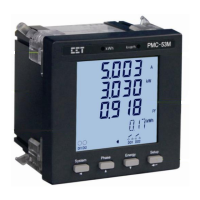Ceiec Electric Technology
40
3) When the residual current sensor is not connected, the value in register 40078 is 0x7FFF.
4) When the temperature sensor was broken or not connected, the value in register 40079 is
30000. When the temperature is below -40°C, the value in register 40079 is -400.
5) The Alarm register indicates the various alarm states with a bit value of 1 meaning active
and 0 meaning inactive. The following table illustrates the details of the Alarm register.
For PMC-53I and PMC-53V, B0 to B2 are reserved.
Table 5-2 Alarm Register (40095)
6) For the DO Status register, the bit values of B0 and B1 represent the states of DO1 and DO2,
respectively, with “1” meaning active (closed) and “0” meaning inactive (open).
7) For the DI Status register, the bit values of B0 and B1 represent the states of DI1 and DI2,
respectively, with “1” meaning active (closed) and “0” meaning inactive (open).
8) The range of the SOE Pointer is between 0 and 0xFFFFFFFF. The SOE Pointer is incremented
by one for every event generated, and will roll over to 0 if its current value is 0xFFFFFFFF.
Since the SOE Pointer is a 32-bit value and the SOE Log capacity is relatively small with only
32 events in the PMC-53, an assumption has been made that the SOE Pointer will never roll
over. If a CLR SOE is performed from the front panel or via communications, the SOE
Pointer will be reset to zero and then immediately incremented by one with a new ”Setup
Changes via Front Panel” or “Setup Changes via Communications” event. Therefore, any
3
rd
party software should assume that a CLR SOE action has been performed if it sees the
SOE Pointer rolling over to one or to a value that is smaller than its own pointer. In this
case, the new SOE Pointer also indicates the number of events in the SOE Log if it is less
than 32. Otherwise, there will always be 32 events in the SOE Log.
5.2 Energy Measurements

